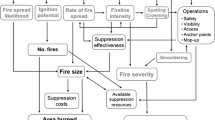Abstract
Recurrent fire has played a dominant role in the ecology of southwestern ponderosa pine forests. To assess the benefits or losses of fire in these forests, a computer simulation model, called BURN, considers vegetation (mortality, regeneration, and production of herbaceous vegetation), wildlife (populations and habitats), and hydrology (streamflow and water quality). In the formulation of the model, graphical representations (time-trend response curves) of increases or losses (compared to an unburned control) after the occurrence of fire are converted to fixedterm annual ratios, and then annuities for the simulation components. Annuity values higher than 1.0 indicate benefits, while annuity values lower than 1.0 indicate losses. Studies in southwestern ponderosa pine forests utilized in the development of BURN are described briefly.
Similar content being viewed by others
Literature Cited
Aldous, S. E. 1944. A deer browse survey method.Journal of Mammalogy 25:130–136.
Andariese, S. W., and W. W. Covington. 1986. Changes in understory production for three prescribed burns of different ages in ponderosa pine.Forest Ecology and Management 14:193–203.
Bock, C. E., and J. F. Lynch. 1970. Breeding bird populations of burned and unburned conifer forests in the Sierra Nevada.Condor 72:182–189.
Campbell, R. E., M. B. Baker, Jr., P. F. Ffolliott, F. R. Larson, and C. C. Avery. 1977. Wildfire effects on a ponderosa pine ecosystem: an Arizona case study. USDA Forest Service, Research Paper RM-191. 12 pp.
Cooper, C. F. 1961. Controlled burning and watershed condition in the White Mountains of Arizona.Journal of Foresty 59:438–442.
Covington, W. W., and S. S. Sackett. 1984. The effects of a prescribed bum in southwestern ponderosa pine on organic matter and nutrients in woody debris and forest floor.Forest Science 30:183–192.
Davis, J. R., P. F. Ffolliott, and W. P. Clary. 1968. A fire prescription for consuming ponderosa pine duff. USDA Forest Service, Research Note RM-155. 4 pp.
Ffolliott, P. F., W. P. Clary, and F. R. Larson. 1977. Effects of a prescribed fire in an Arizona ponderosa pine forest. USDA Forest Service, Research Note RM-336. 4 pp.
Gordon, K. 1943. The natural history and behavior of the western chipmunk and the mantled ground squirrel. Oregon State Monograph, Studies in Zoology, No. 5. 104 pp.
Haase, S. M. 1986. Effect of prescribed burning on soil moisture and germination of southwestern ponderosa pine seed on basaltic soils. USDA Forest Service, Research Note RM-462. 6 pp.
King, J. A. (ed.) 1968. Biology of Peromyscus. American Society of Mammalogists, Special Publication No. 2, Stillwater, Oklahoma. 593 pp.
Kruse, W. H. 1972. Effects of wildfire on elk and deer use of a ponderosa pine forest. USDA Forest Service, Research Note RM-226. 4 pp.
Lindenmuth, A. W., Jr. 1961. Effects on fuel and trees of a large intentional burn in ponderosa pine.Journal of Foresty 60:804–810.
Lowe, P. O., P. F. Ffolliott, J. H. Dieterich, and D. R. Patton. 1978. Determining potential wildlife benefits from wildfire in Arizona ponderosa pine forests. USDA Forest Service, General Technical Report RM-52. 12 pp.
Morris, W. G., and E. L. Mowat. 1958. Some effects of thinning a ponderosa pine thicket with prescribed fire.Journal of Foresty 56:203–209.
Pearson, H. A., J. R. Davis, and G. H. Schubert. 1972. Effects of wildfire on timber and forage production in Arizona.Journal of Range Management 25:250–253.
Sackett, S. S. 1984. Observations on natural regeneration in ponderosa pine following a prescribed fire in Arizona. USDA Forest Service, Research Note RM-435. 8 pp.
Schubert, G. H. 1974. Silviculture of southwestern ponderosa pine: the status of our knowledge. USDA Forest Service, Research Paper RM-123. 71 pp.
Sims, B. D., G. S. Lehman, and P. F. Ffolliott, 1982. Some effects of controlled burning on surface water quality.Hydrology and Water Resources in Arizona and the Southwest 11:87–90.
Wagle, R. F., and T. W. Eakle. 1979. A controlled burn reduces the impact of a subsequent wildfire in a ponderosa pine vegetation type.Forest Science 25:123–129.
Author information
Authors and Affiliations
Rights and permissions
About this article
Cite this article
Ffolliott, P.F., Guertin, D.P. & Rasmussen, W.D. Simulating the impacts of fire: A computer program. Environmental Management 12, 809–814 (1988). https://doi.org/10.1007/BF01867608
Issue Date:
DOI: https://doi.org/10.1007/BF01867608




